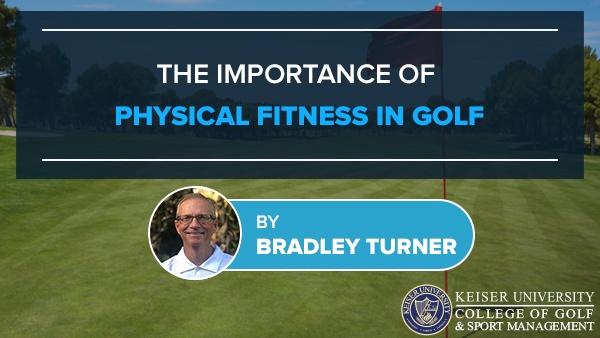The Importance of Physical Fitness in Golf

By Bradley Turner, Keiser University College of Golf Director of Online Golf Instruction – MBA, PGA
Golf has traditionally been perceived as a leisure sport where athleticism is not a requirement to participate. That statement is true, but if you want to perform at your peak, a crucial aspect is for golfers to be in good physical condition. Hall of Fame golfer Gary Player may have inspired a handful of golfers to focus on fitness, but Tiger Woods made it mandatory practice for world-class professionals. The majority of players on the PGA Tour and LPGA Tour now include strength training and flexibility as part of their practice routines. This article will highlight a few simple actions any golfer can take to enhance physical performance, prevent injuries, and contribute to a holistic approach to the game of golf.
The Role of Physical Fitness in Golf
Golf requires a combination of strength, flexibility, and endurance to execute golf shots with precision and power. Conditioning the body through regular exercise improves muscle tone, agility, and overall physical prowess, enabling golfers to reach their peak performance. Strength training can focus on enhancing power and increasing clubhead speed, contributing to greater distance off the tee. Flexibility routines such as yoga can significantly improve the golfer’s range of motion, which can also contribute to greater clubhead speed and distance. Cardiovascular endurance is essential for those walking the golf course. Walking a typical 18-hole golf course will amount to a 5 or 6-mile stroll over the hills and through the woods. If the golf course has elevation changes, you are in for a quality workout just by walking the golf course.
Preventing Injuries
The repetitive nature of the golf swing can put a strain on a golfer’s body. Adequate stretching is one of the most important benefits of injury prevention. Another factor in joint injuries is weak muscular conditioning, forcing the ligaments and tendons in the joints to fatigue. This results in tendonitis, which is a debilitating condition preventing athletes from playing their sport. Tendonitis is a common injury for golfers. However, with a few golf-specific exercises, you will be back on the course in short order.
A Fitness Plan: Golf-Specific Exercises
Creating a targeted fitness plan that focuses on each golfer’s specific needs is a step in the right direction. A great resource is golf-specific trainers who can help design a fitness program unique to each golfer. Another economical source of golf-specific exercises is the book Golf Anatomy by Craig Davies and Vince Disaia. The Golf Anatomy book explains the purpose and benefits of suggested exercises. The book also includes detailed drawings of performing the exercises properly.
A fitness plan should be a distinctive design based on the golfer’s strength and flexibility. However, a general rule is for a golfer to begin with stretching and mobility exercises before progressing to strength and power training. Golf Anatomy provides a plethora of information on golf-specific exercises to get golfers physically prepared to play their best.
Nutrition and Its Role in the Golfer’s Performance
A big breakfast in the morning, including bacon, eggs, hashbrowns, pancakes, or freshly baked biscuits, is often thought to be a perfect way to prepare for your morning round of golf. However, a heavy breakfast or meal before golf can slow you down as the body focuses on digestion, not executing golf shots. The best course of action is to plan a light meal of healthy proteins and energy fruits such as strawberries and bananas. Unlike most sports, a competitive golfer will spend an hour on the range and short game area before the start of the round. Add another 4 or 5 hours of golf, and it can be a long time between meals. A good strategy is to pack snacks to consume throughout the round of golf, such as trail mix, apples, and protein bars. Tiger Woods is known to eat peanut butter sandwiches during the round to keep his glucose levels consistent. You should, at minimum, have a snack two separate times during the round, preferably three to four times. With the proper nutrition to fuel the body, you will avoid sluggish starts or famished finishes to a round of golf.
The Long-Term Benefits of Physical Fitness in Golf Education Programs
A primary benefit for every golfer who employs a fitness program is the increased longevity in the game. Plenty of research has found that avid golfers have a longer life span than non-golfers. It is good to know that the more you play golf, the more likely you will add a few years to your life. If you want to play golf well into your retirement years, keep your body in good shape.
The importance of physical fitness in golf education cannot be overstated. Beyond the swing mechanics and mental strategies of the game, a well-conditioned body is essential for you to play at your potential. From enhancing performance to preventing injuries, a holistic approach to the game of golf is a key ingredient in the recipe for a lifetime of golfing excellence and overall physical well-being.
Learn more!
Want more tips? If you want to take your game to the next level, contact our team at Keiser University’s College of Golf & Sport Management today. With our dedication and experience, we can elevate your game to new heights together. Give us a call today at 888-355-4465.













Very useful tips and lessons learnt.